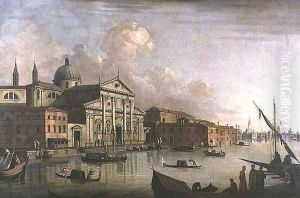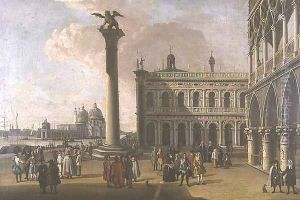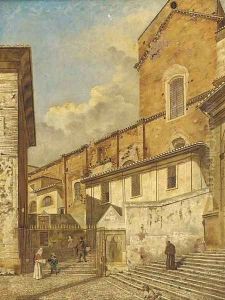Follower of Canaletto, Antonio Paintings
Antonio Canal, better known as Canaletto, was an Italian painter of the Venetian school and a significant figure in the 18th-century Venetian art scene. Born on October 18, 1697, in Venice, Italy, he is renowned for his grandiose and precise cityscapes, or vedute, of Venice, which captured the city's unique light and architecture with extraordinary clarity and detail.
Canaletto began his career as a theatrical scene painter, working alongside his father, who was also a painter. However, he soon transitioned to painting the cityscapes for which he would become famous. His early works were influenced by fellow Venetian artist Luca Carlevarijs but Canaletto soon developed his distinct style characterized by meticulous attention to detail and the use of the camera obscura to achieve precise perspective.
During the 1730s, Canaletto's work became increasingly popular with British collectors, who were undertaking the Grand Tour of Europe. The demand for his paintings was so high that he sent many works to England through the art dealer Joseph Smith, who was later appointed British Consul in Venice. Smith became Canaletto's agent and one of his most important patrons, eventually selling his extensive collection of Canaletto's works to King George III, forming the basis of the Royal Collection's holdings of his work.
In 1746, as the war between Britain and France (part of the War of the Austrian Succession) led to a decline in the number of British visitors to Venice, Canaletto moved to London. There he continued to paint views, but now of the Thames and other English landscapes. His English works, however, did not achieve the same success as his Venetian vedute, and by 1756 he returned to Venice, where he remained until his death in 1768.
Canaletto was not only a painter but also an important printmaker, producing etchings that further disseminated his views of Venice. His influence extended beyond his lifetime, with his nephew and pupil, Bernardo Bellotto, who was also known as 'Canaletto' in some cities of Northern Europe, continuing his uncle's tradition. The term 'Follower of Canaletto' is used to refer to artists who were either influenced by Canaletto's work, were his pupils, or painted in a style similar to his. These followers played a crucial role in perpetuating the veduta genre and Canaletto's artistic legacy.
Canaletto's works are celebrated for their accuracy and are invaluable to historians for their detailed representation of 18th-century Venice. Today, his paintings are held in prestigious museums around the world, including the Louvre in Paris, the Metropolitan Museum of Art in New York, and the National Gallery in London.


